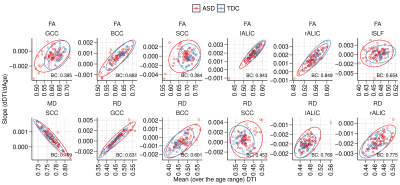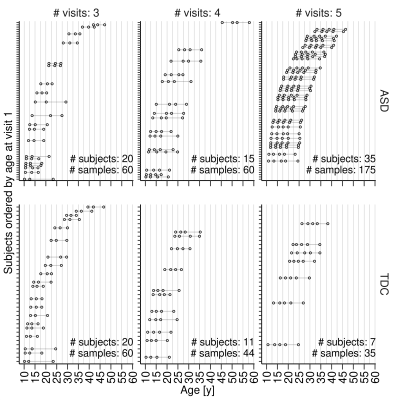Nagesh Adluru1, Douglas C Dean III1, Molly Prigge2, Jace B King2, Nicholas T Lange3, Erin D Bigler4, Brandon Zielinski2, Janet E Lainhart1, and Andrew L Alexander1
1UW-Madison, Madison, WI, United States, 2University of Utah, Salt Lake City, UT, United States, 3Harvard Medical School, Boston, MA, United States, 4Brigham Young University, Provo, UT, United States
1UW-Madison, Madison, WI, United States, 2University of Utah, Salt Lake City, UT, United States, 3Harvard Medical School, Boston, MA, United States, 4Brigham Young University, Provo, UT, United States
Individuals with autism spectrum disorder exhibit significantly different and more variable trajectories of DTI measures in adolescent children and young adults.

Figure 4. The bivariate distributions that showed statistical significance with FDR adjusted p≤0.05. Significance: BC of the bivariate distributions show the amount of overlap between the distributions. ASD group shows increased heterogeneity compared to the TDC. The analysis revealed all of the sub-fields of the corpus callosum (CC), i.e., genu, body and splenium, as well as the left (but not right) superior longitudinal fasciculus as statistically significant which have been consistently shown as important white matter regions in studying ASD. FA, RD are more sensitive than MD.

Figure 1. Overview of the samples from the accelerated longitudinal design (ALD) analyzed in this study. The total number of subjects and samples are shown in the panels separated by the total number of visits and the groups. Significance: An ALD helps investigate individual level rates of change and temporal averages that even a large cross-sectional study cannot empower. Assuming a moderate acceleration in the cohort, an ALD makes such investigation over longer age ranges feasible, compared to synchronized longitudinal studies.